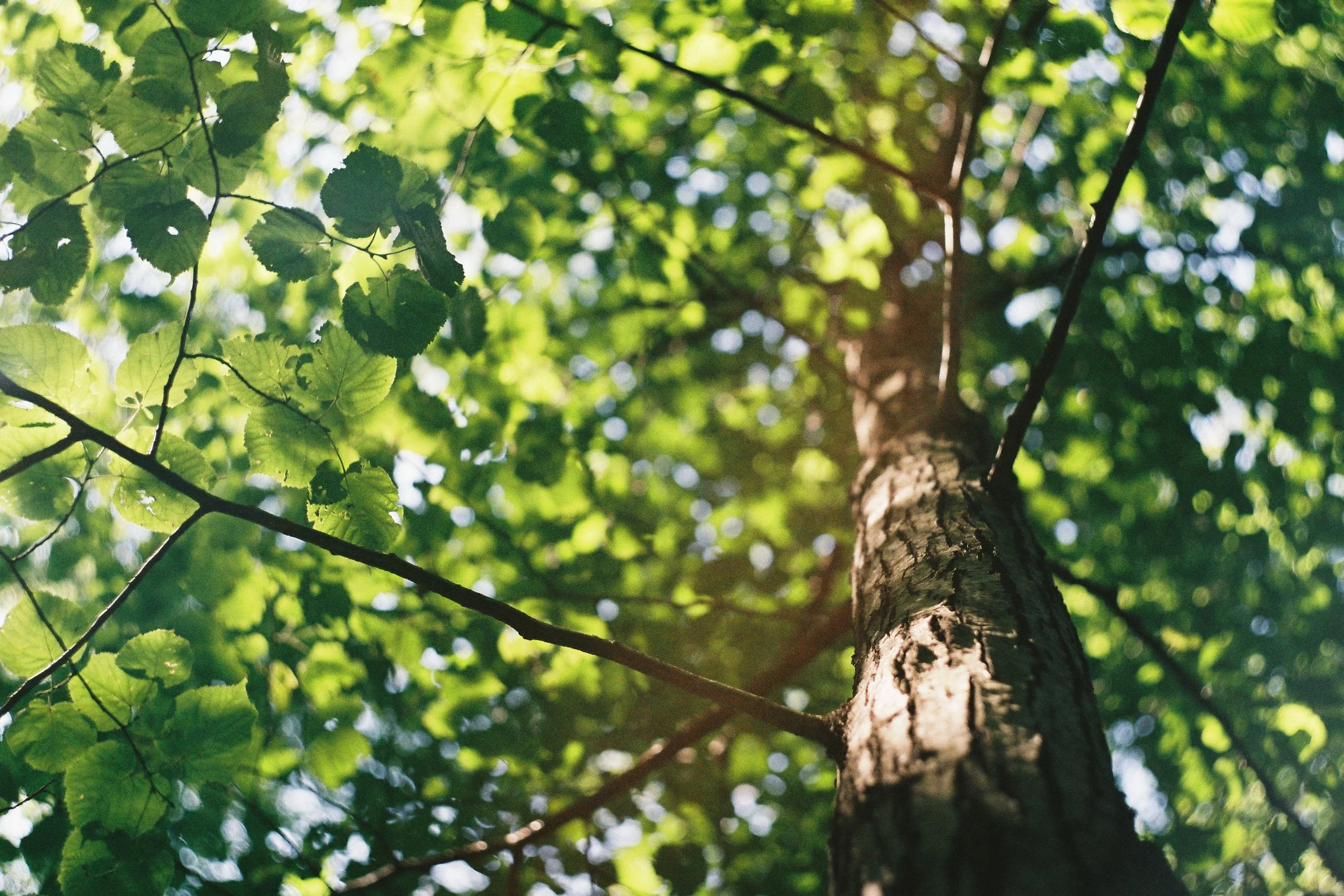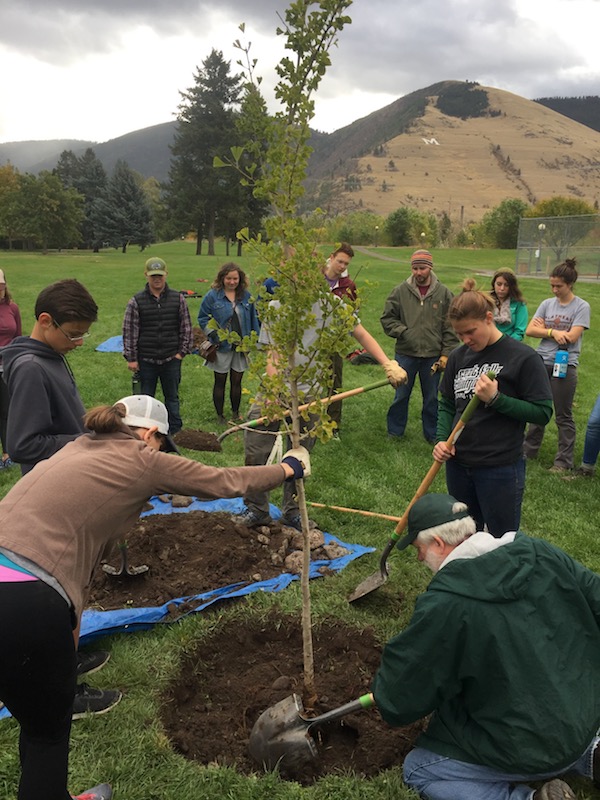Planting
You want to plant a tree? Great! Let’s get started.
If you received a tree at Run for the Trees…
Check out species info below and scroll down for planting tips!
Ponderosa Pine
Pinus ponderosa
Height at maturity: 60 – 100 feet
Growth rate: moderate
Sun / soil / water: Prefers full sun and deep, well drained soils. Drought tolerant native.
Western Larch
Larix occidentalis
Height at maturity: 90 – 120 feet
Growth rate: moderate
Sun / soil / water: Not tolerant of wet soils - prefers well-draining soils. Very cold tolerant.
Other: At full growth, this is a very large tree, so plant only where there is space!
Golden Currant
Ribes aureum
Height at maturity: 10 feet
Growth rate: moderate
Sun / soil / water: Sun to partial shade. Adaptable shrub that thrives in moist or drier soils – can tolerate standing water to drought.
Other: Produces delicious, edible fruit. Flowers provide nectar to hummingbirds, butterflies and bees, and fruits are food for birds, bears & rodents.
Bur Oak
Quercus macrocarpa
Height at maturity: 70 – 80 feet
Growth rate: slow
Sun / soil / water: Full sun and well drained soils.
Other: Very large oak tolerant of most urban conditions. Needs developmental pruning. Produces annual acorn crop that feeds bears, squirrels, mice. Excellent tree for carbon sequestration!
Chokecherry
Prunus virginiana
Height at maturity: 25-30 feet
Growth rate: moderate - fast
Sun / soil / water: Drought & cold tolerant native. Full sun to shade. Prefers well-draining soil. Can grow in a wide range of soil types. Is susceptible to salt damage.
Other: Produces large quantities of red to black fleshy fruit. Fruits are edible, high in anti-oxidants, and can be dried or made into syrup or juice to treat colds.
Chokecherry trees are susceptible to black knot.
Planning for Planting
The Right Tree in the Right PlacE
What makes a tree right/suitable/appropriate? A few things must be taken into consideration when choosing the best tree for you and your planting location.
WHAT TYPE OF TREE SHOULD i PLANT TO SURVIVE Missoula’s climate?
Missoula’s climate is classified as semi-arid with an average rainfall of only 14” of precipitation per year, and most landscape trees require an average of 25-35”. These very dry conditions cause large summer temperature variations and allow early and late hard frosts to occur, which can damage or kill many species of trees. The cyclical low temperatures of -20 to -25 F places Missoula in USDA Plant Hardiness Zone 4b.
With conditions changing due to climate impacts, it’s important to select species that are adaptable as Missoula becomes warmer. Check out our working list of climate resilient tree species below! For a longer list of street trees appropriate for Missoula, check out the City of Missoula’s Approved Street Tree List.
CLIMATE RESILIENT TREE SPECIES SUGGESTIONS FOR MISSOULA
Heat tolerance: Sensation Boxelder (Acer negundo), New Horizon Elm (Ulmus davidiana), Honeylocust (Gleditsia triacanthos)
Drought tolerance: Gambel oak (Quercus gambeii), Hackberry (Celtis occidentalis), Ponderosa pine (Pinus ponderosa), Doug Fir (Pseudotsuga menziesii), Sensation Boxelder (Acer negundo), Honeylocust (Gleditsia triacanthos)
Pest/pathogen resistance: American Linden (Tilia americana), Bur Oak (Quercus macrocarpa), Swamp white oak (Quercus bicolor)
Shade: Northern red oak (Quercus rubra), Sugar maple (Acer saccharum), New Horizon Elm (Ulmus davidiana), Purple Catalpa (Catalpa speciosa), Horse Chestnut / Northern buckeye (Aesculus glabra)
Native: Ponderosa pine (Pinus ponderosa), Bur Oak (Quercus macrocarpa) , Chokecherry (Prunus virginiana), Serviceberry (Amelanchier alnifolia)
Why do you want to plant a tree?
Aesthetics: Trees soften our built environment and make our spaces more pleasant. Looking for flowers? Fall color? Interesting bark? Particular shape? Deciduous or coniferous?
Shade: Trees cool our space. Do you need shade where you like to sit, relax or entertain? Does your house need shade from the harsh summer sun?
Windbreak: Deciduous and coniferous trees provide protection from wind all year long. Does an area or building need protection from the wind?
Visual Pollution: Trees provide a natural, living screen. Do you have a feature you need to conceal? Do you have a view you would like to block out? Do you need privacy?
Noise Pollution: Trees dampen the sounds created by living in an urban environment. Are there busy streets or businesses nearby? Are you in a densely populated area?
Where do you want to plant a tree?
Do your research before you purchase a tree.
What is the mature size of the tree?
Height: Are there any overhead utility lines?
Width: Will the tree have room to spread without interfering with buildings or other trees?
Depth: Are there any underground utilities? Call 811 whenever you dig!
Each of these factors will help determine what size tree you should plant.
How much sunlight will the tree receive?
On a sunny day, observe your proposed planting location. How many hours of direct sunlight will your tree receive?
Full Sun = 6 or more hours a day
Part Sun/Part Shade = 2-5 hours a day
Full Shade = Less than one hour a day or dappled sunlight
Most trees grow best in full sun. However, if you have some shade, look for appropriate species and varieties that will do well in that location.
Will the tree receive water?
All trees need water, especially while they are getting established during their first years in the ground. How will your tree be watered?
Automatic Irrigation?
Slow-drip/Soaker/Sprinkler Hoses?
Sprinkler?
Buckets?
Even “drought-tolerant” trees thrive better with consistent water, and all urban trees need supplemental watering during our hottest and driest months – typically July, August and September.
For more information about how to water efficiently and effectively, click here.
Is there enough healthy soil to support the tree?
Trees not only rely on sunlight and CO2 for life, they also rely on what the soil provides.
What makes soil “healthy”?
Minerals and Nutrients
Organic Matter
Air
Water
Are you replacing a plant/tree that did not do well in the same location? Consider having your soil tested.
How does compacted soil affect a tree’s growth?
Often where there is new construction, the soil is usually compacted, rarely healthy and needs to be amended and/or healthy soil brought in. Compaction restricts the root growth and the flow of necessary air and water vital for tree health.
How does the soil drain?
If your planting area drains slowly, there may be a high clay content or it could be a sign of compaction. Some tree species prefer wet sites, but some thrive in well-drained locations. Be sure to choose a tree species that can handle the moisture content of your soil.
Planting Trees Properly
After you have chosen the right tree for the right place, it’s time to plant! This is the first, most important step in an urban tree’s life, and using the proper planting techniques will help ensure your tree will have the best chance at not only surviving, but also thriving.
When is the best time of year to plant trees?
Root Ball Types
Missoula is in Zone 4 for plant hardiness, so it’s generally best to plant trees in the fall after leaf drop or in early spring before bud-break — when temperatures are cool, moisture is up and the trees have some time to stabilize themselves before either the heat of summer or the cold of winter.
How to Properly Plant Bare Root, Containerized and Ball & Burlap Trees
Please refer to the following City of Missoula Parks & Recreation approved planting notes and details PDFs.
How to Properly Plant your Run for the Trees Tree Seedling
Thank you for participating in the annual Run for the Trees and for supporting our urban forest! This little seedling will grow into a large tree if all goes well, so be sure to find the appropriate location for its mature size.
Dig a hole large enough to accommodate the roots. Spread the roots out as much as possible to encourage growth.
Gently backfill soil into the planting hole, making sure to remove any deadly air pockets without compacting the soil around the roots.
Be sure you can see the root flare, where the trunk meets the structural root(s).
Water thoroughly, removing any remaining air pockets.
Apply mulch to help keep the soil and roots cool and moist. Keep mulch from touching the trunk.
Protect the small seedling from pets, wildlife, lawnmowers and weed trimmers.
Enjoy!
Tree Planting Tips
Prune only broken or dead branches at time of planting. Formative pruning can take place after your tree has spent 2 years in the ground getting acclimated.
Do not apply fertilizer at planting time.
Planting hole should be 2-3 times the size of the root ball.
Straighten or prune out any circling roots, so new roots grow away from the trunk.
Do not allow the roots to dry out. Keep them protected and moist.
Remove the container or wire caging and burlap from the tree before planting, being careful to keep the root ball in tact.
Remove any tags, wires, strings, etc. to prevent them from restricting growth.
Gently backfill soil into the planting hole, making sure to remove any deadly air pockets without compacting the soil around the roots.
You should be able to see the root flare, the point where the top structural root(s) meet the trunk, after backfilling the planting hole. The quickest way to kill a tree is to plant it too deeply.
Stake a tree only if it is in a high wind area, and then stake only for a few years. A tree’s natural movement in normal wind situations makes the trunk stronger.
Use mulch to help keep the roots retain moisture and stay cool. Use rock mulch only when necessary, as it tends to heat up the soil around the roots.
Keep the mulch from piling against the tree trunk. It is important to give the root flare air and sunlight.
Water thoroughly after installation to remove any remaining air pockets.
It’s best to plant trees when temperatures are cooler, when possible.





